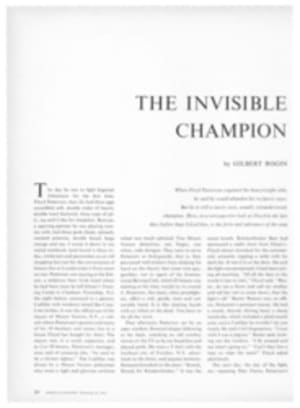
Living high on the high seas
Every pastime that lures its devotees into the outdoors has a few hair-shirt characters who think it necessary to rough it, even gastronomically. Whether they are hunting or camping or fishing or cruising, their only thought of food is, "Open another can of beans."
Beans—some beans—are fine, and there is no reason why food fetishists should be allowed to interfere with the fun at hand. But good eating is pleasure, too, and in a small boat on the ocean a hot, palatable meal and a dry, warm bunk can often make the difference between joy and misery.
Having had the good fortune to spend a fair percentage of my life beyond the range of supermarkets or even ice, I have given much thought to the basic supplies that form what might be called de luxe iron rations. The items on such a list must be able to last for several weeks without refrigeration, granted a cool and well-ventilated locker. Their number must be kept reasonably small for ease of stowage, but they must be flexible enough to form the ingredients for more than one dish. The primary purpose of these rations is not to maintain life in an emergency but to provide independence from civilization, to permit swinging at anchor extra days in some secluded harbor, to compensate for dispiriting calms on an ocean passage.
Obviously, such a larder must depend heavily on canned items, supplemented by a few dried foods. For example, one item on the list is canned chicken sections. These may be curried, served with cream sauce, heated with stewed fresh vegetables or stripped from the bones and combined with chow mein vegetables and rice for a Chinese meal. Similarly, rice may be bubbled golden in butter in a frying pan, added to clear bouillon (made from a can or a cube) or sweetened to make a dessert pudding. With a few slivers of onion and truffle, the same rice can become a creditable pilaf, or one can blend it with freshly grated Parmesan cheese for a fine risotto.
Salad presents more of a challenge to the seagoing cook, but cabbage keeps well for slaw, and some canned vegetables—baby string beans, beets, hearts of palm and asparagus, for example—drained and marinated with diced fresh onions in the right tart French dressing can taste as though they had come right from the farm. Cheeses such as Dutch Edam and Italian Parmesan keep indefinitely, and the latter, grated immediately before using, glorifies an amazing variety of dishes. Fresh milk and cream can never be truly duplicated, of course, but dried skim milk, with powdered cream added to provide richness and body, makes a perfectly satisfactory substitute for cooking, even in sauces.
Eggs are no problem at all in the shipboard larder, since they will stay fresh for weeks when coated by an invisible film of plastic. Neither is bread, if you get the white and whole wheat canned by Horlamus of Miami. Canned butter is virtually indistinguishable from fresh.
How many dishes for how many meals can be prepared from this list? Frankly, I don't know. I have been experimenting with seagoing menus for a long time and I still come up with new variations. Granted, you may miss that thick rare steak, but if you use this list with imagination you won't be gastronomically bored.
I have included brand names wherever I considered them necessary to guarantee a form or flavor I personally prefer—not that other brands may not be equally good.
'FINISTERRE'S' DE LUXE IRON RATIONS
SOUP
Chicken and beef bouillon cubes (Knorr-Swiss); clam chowder (Snow); concentrated mushroom, tomato, green pea, black bean, beef consommé (Campbell); chicken consommé" (White Rose).
FISH
Tuna; lobster; crab (Japanese or Alaskan); anchovy fillets; sardines; minced clams (Snow).
MEAT
Ham (Danish or Dutch in small sizes); chicken sections (Randall); beef cubes with gravy (Friend); roast beef (Swift); corned beef; dried beef; tongue (Derby); frankfurters; Canadian bacon (Greentree); salt pork and bacon in slab.
DAIRY
Plastic-coated eggs; canned butter (Viking); powdered skim milk (Starlac); powdered cream (Pream); evaporated milk (Carnation); Edam cheese; Parmesan cheese (in chunk).
FRESH VEGETABLES
Onions, potatoes, carrots, turnips, leeks, cabbage, garlic.
CANNED VEGETABLES
Small green peas; baby lima beans; baby string beans; asparagus; whole-kernel corn (Green Giant); baby beets; whole tomatoes (Hunt); tomato paste; tomato aspic; sweet potatoes (dry pack); Boston-style beans (B & M); mushrooms (B in B); hearts of palm; sauerkraut; truffles; chow mein vegetables (meatless pack) and Chinese noodles.
DRIED VEGETABLES
Split green peas, yellow peas.
PASTA, BREAD, ETC.
American noodles; Italian spaghetti; rice (Uncle Ben's); instant mashed potatoes (French); white and whole-wheat bread (Horlamus); plain croutons (S.S. Pierce); Swedish crisp rye bread (Ry-King, yellow label); crackers in tins (Keebler); quick-cooking oatmeal.
CONDIMENTS, COOKING NEEDS
Salt; black pepper (whole corns); coffee; tea; instant cocoa (Nestlé); catsup; chili sauce; Worcestershire sauce; powdered English mustard (Colman); prepared mustard; mayonnaise (Hellman's); olive oil (Old Monk); vegetable oil (Mazola); vegetable shortening (Crisco); vinegar; gelatin; Tabasco; soy sauce; chutney (Major Grey's); capers; white and brown sugar; vanilla extract; all-purpose flour; baking powder; lemon and lime juice (in plastic containers); MSG (Accent); spices (curry powder, thyme, basil, orégano, bay leaves, paprika, saffron, nutmeg, cinnamon, cayenne pepper).
DESSERTS, ETC.
Noncooking instant chocolate and vanilla pudding (Jell-O); plum pudding; pound cake (Vacuum); shortbread (Keiller); assorted cookies (Peek Frean); jams and marmalade; nuts (peanuts, almonds, walnuts); honey; molasses; maple syrup.
FRUITS
Canned grapefruit sections, pineapple rings, baked apples, Kadota figs, cherries; fresh apples; dried fruit (raisins, prunes, apricots, peaches, figs).
JUICES
Orange-grapefruit, prune, pineapple, tomato and/or V-8.
BAR
For cooking and dining: rum, wines and cordials, as desired.
ILLUSTRATION

